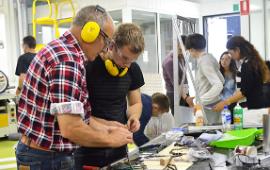Makeathon for assistive technology crosses finish line

In Summary
- Tikkun Olam Makers present prototypes
- Prizes will help to develop assistive technologies further
As 72 hours of non-stop collaboration and creativity came to a close, one TOM Makeathon team was furiously willing the metallic paint on its portable wheelchair ramps to dry.
“I don’t think we cut it too fine at all,” team member Len Lines says. “We had about three minutes to spare...”
It was a risk they had to take – one of the only requests from recipient Stacey Christie was that the ramps be a shimmering gold.
The other was to create something that would allow her to travel the world. Which is exactly what they did.
The team presented their prototype, a pair of lightweight ramps that can be lowered and picked up by a magnetic stick, at the finale of the Makeathon on Wednesday evening.
The system means Miss Christie, who has a type of muscular dystrophy and uses an electric wheelchair, can independently traverse the steps and kerbs peppered throughout our cities.
“It’s amazing what they have come up with in such a short amount of time,” she says. “It really works.”
Australia first
The team was one of 10 participating at the three-day event that brought together engineers, developers, students and health professionals to create assistive technology for people living with a disability.
TOM stands for Tikkun Olam Makers, with Tikkun Olam translating to ‘repairing the world’ in Hebrew. Hosted by the Swinburne Innovation Precinct, it was the first time the Makeathon had been held in Australia.
“The idea of bringing people from across the university and industry together to share knowledge and solve challenges is exactly what we are about,” says Innovation Precinct director Professor Sally McArthur.
“It was really exciting to see the incredible things that can be achieved and we were so impressed by the quality of the outcomes that will help not only one person, but potentially thousands.”
Collaboration and teamwork characterise the event and there were plenty of examples to be found.
Occupational therapist Ina Stavril spent most of the 72 hours helping her team come up with a system that aids in dressing and undressing.
However, she also ended up teaching another team cross stitch and sewing yet another team’s fabric wheelchair insert.
"It was the type of atmosphere where everyone came together to share their expertise," she says.
Real outcomes
Designs of the prototypes created over the course of the event have been uploaded online so that people across the world can freely access them.
Each team was awarded a prize package that will help them further develop and potentially commercialise their innovations.
One team, made up primarily of Swinburne bio-engineering students, was selected by the Swinburne Innovation Precinct to receive $2,000 worth of consultation. This will provide them with support and advice to develop their wheelchair pressure sensor system.
Prototypes from other teams included:
- a tricycle that allowed a quadruple amputee to ride again,
- an adapted PlayStation controller for those with limited hand function,
- a device that turns a laptop on or off hands-free,
- a magnetic bracelet to help curb hand tremors while writing,
- crutches that convert into a seat,
- a motorised head rest that supports a full range of head movement, and
- an adapted system for browsing the internet hands-free.
"We are excited to see how Swinburne can continue to be involved as these ideas move forward," says Professor McArthur.

